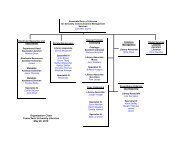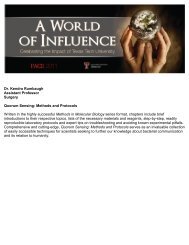Nonprofit Organizations Law and Policy Third Edition - Libraries ...
Nonprofit Organizations Law and Policy Third Edition - Libraries ...
Nonprofit Organizations Law and Policy Third Edition - Libraries ...
You also want an ePaper? Increase the reach of your titles
YUMPU automatically turns print PDFs into web optimized ePapers that Google loves.
CHAPTER 1<br />
OVERVIEW OF THE NONPROFIT SECTOR<br />
• • •<br />
I. NATURE OF A NONPROFIT<br />
ORGANIZATION<br />
The role of the third sector in society, even the concept of the<br />
nonprofit organization, is somewhat unclear. Although one expert on<br />
nonprofit law calculated some years ago that almost half of the organizations<br />
<strong>and</strong> enterprises in the United States at that time were nonprofit in<br />
nature,l there remains a misconception of the nonprofit sector. The types<br />
<strong>and</strong> forms of nonprofit enterprises are varied, <strong>and</strong> they serve many <strong>and</strong><br />
diverse purposes in a community. Some are formed to further the general<br />
welfare of members of a community. Some are organized for specific<br />
charitable purposes-whether educational, religious, artistic, literary, or<br />
scientific. 2 Some are formed to benefit their members exclusively. The<br />
charitable organization, funded for the most part through donations, is<br />
the type of organization the public generally associates with nonprofit<br />
status. There are, however, many nonprofit organizations that are not<br />
charitable organizations. Political organizations, professional <strong>and</strong> trade<br />
organizations, social clubs, homeowners' associations, <strong>and</strong> employee organizations<br />
are a few examples. There are numerous nonprofit organizations<br />
of a commercial nature that derive most of their funds from profits<br />
generated by operations. Hospitals, day care centers, retirement villages,<br />
country clubs, <strong>and</strong> farmers' cooperatives are examples of profit-making<br />
entities often established as nonprofit corporations. Some nonprofit organizations<br />
have been identified as nongovernmental organizations (NGOs)<br />
1. See Howard Oleck, Nature of <strong>Nonprofit</strong> <strong>Organizations</strong>, 10 U. Tol. L. Rev. 962 (1979), In<br />
2002 Statistics of Income, the Internal Revenue Service reported that assets of charitable<br />
organizations rose, from $423 billion in 1985 to $1.733 trillion in 2002. The five percent of<br />
organizations with assets of $10 million or more held 89'7< of these assets. See data at www.irs.<br />
gov/taxstats.<br />
Lester M. Salamon reported that there were 1.6 million identifiable nonprofit organizations in<br />
1995 with revenues as of 1996 of $670 billion. See Lester M. Salamon, "Scope <strong>and</strong> Structure: The<br />
Anatomy of America's <strong>Nonprofit</strong> Sector," in The Nature of the <strong>Nonprofit</strong> Sector, J. Steven Ott,<br />
ed., Westview Press, 2001, p. 23. The number has grown to 1.9 million since 1995. See IRS Data<br />
Books Publication Table, p. 25.<br />
2. These organizations seek tax exempt status as § 501(c)(3) organizations. Discussion in<br />
Chapters 4, 6, <strong>and</strong> 7.<br />
1
















